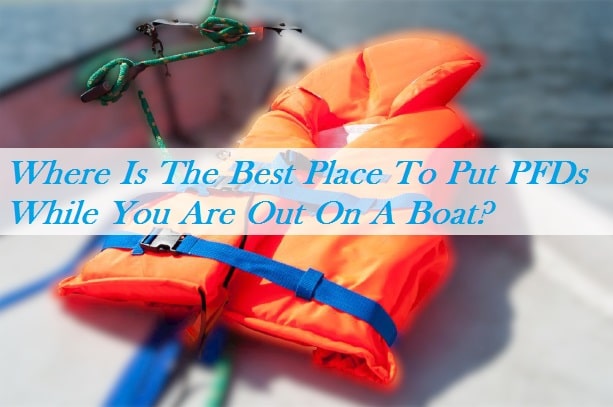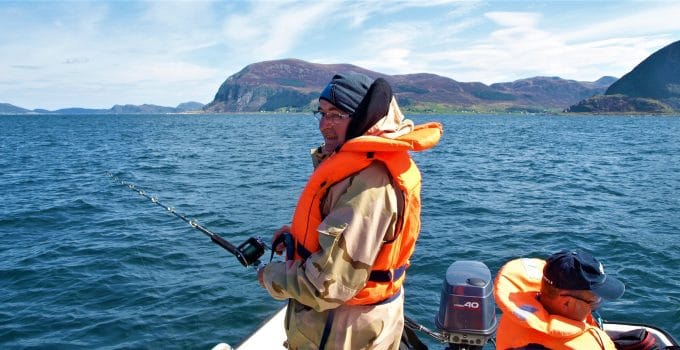Where Is The Best Place To Put PFDs While You Are Out On A Boat? There is no doubt, skippers and their passengers face a lot of danger every time they hit the waterways. Fortunately, there are precautions that can be taken to minimize these risks.
One particular safeguard that comes to mind is related to the Personal Flotation Device, better known as PFD in the marine and boating industries. A PFD is a device that helps an individual who falls or jumps overboard remain buoyant (afloat) in the water.
Where Is The Best Place To Put PFDs While You Are Out On A Boat?
Boating Accident And Fatality Statistics
In 2019, 2,559 people were injured and 613 fatalities related to boating accidents were reported in the United States. The fatality numbers (633) were slightly down from 2018 while the injury numbers had increased by 58.
Fewer boating injuries and fatalities related to boating accidents were reported in 2018 and 2018, compared to 2017 – 658 fatalities and 2,629 injuries, according to the US Coast Guard (USCG).
In the United States, monetary damages related to recreational boating accidents tallied up to more than $55 million in 2019. The numbers were up from 2018, which was reported to be more than $45 million, a $10 million variance, according to the US Coast Guard.
Recommended: What Piece Of Equipment On A Boat Is Most Important In Preventing Propeller Strike Injuries?
US Coast Guard PFD Regulations
The US Coast Guard oversees water safety in the United States. The agency developed a set of guidelines for both recreational and commercial boating PFDs. The guidelines recognize four types of recreational boating PFDs:
- PFD Type I – Recommended for all waterways, including remote water, rough seas, and open ocean or when rescue is expected to be delayed. Type I PFDs include the Inherently Buoyant, Inflatable, and Hybrid.
- PFD Type II – Recommended for general recreational activities in inland and calm waters or when rescue is expected to occur quickly. Type II PFDs include the Inherently Buoyant, Inflatable, and Hybrid.
- PFD Type III – Recommended for specialized or general recreational activities, such as fishing, kayaking, hunting, canoeing, and skiing. Better suited for inland and calm waters or when rescue is expected to occur quickly. Designed to offer flexibility when performing basic water activities. Type III PFDs include the Inherently Buoyant, Inflatable, and Hybrid.
- PFD Type V – Recommended for special conditions. Type V PFDs include the Kayak/Canoe vest, deck suit, hybrid inflatable, boardsailing vest, commercial whitewater vest, law enforcement flotation device, man-overboard rescue device, and commercial work vest.
Recommended: What Causes A PFD To Wear Out?
Adult PFD Buoyancy Ratings
Newtons chart is designed to help American consumers choose a PFD that is suitable for their boating needs and preferences. Higher buoyancy equals a higher lift, according to the Newtons’ chart.
- Type I Inflatable PFD – Buoyancy 33.0 (150 pounds)
- Type I Buoyant Foam (Kapok) – Buoyancy 22.0 (100 pounds)
- Type II Inflatable PFD – Buoyancy 33.0 (150 pounds)
- Type II Buoyant Foam (Kapok) – Buoyancy 15.5 (70 pounds)
- Type IIIHy Inflatable – Buoyancy 22.0 (100 pounds)
- Type III Buoyant Foam (Kapok) – Buoyancy 15.5 (70 pounds)
- Type V Hybrid Inflatable PFD – Buoyancy 22.0 (100 pounds when fully inflated) Buoyancy 7.5 (34 pounds when deflated)
- Type V Inflatable Special Use PFD – Buoyancy 22.0 – 34.0 (100 to 155 pounds)
- Type V Buoyant Foam Special Use PFD – Buoyancy 15.5 t0 22.0 (70 to 100 pounds)
Read This: What Is The Main Advantage Of A Type IV PFD?
Wearing Versus Not Wearing
The US Coast Guard runs public campaigns annually before the summer season is set to kick in. The campaigns alert boaters and their passengers of drowning risks associated with unintentional recreational boating accidents.
Contrary to belief, more recreational boating accidents take place in calm and inland waters than in the rough seas. This perception is why some boaters opt to store their PFDs instead of wearing them.
Once an individual falls overboard, it is too late to grab for the PFD, which is why the Coast Guard urges wearing instead of storing.
Wearing a PFD does not mean leaving the fasteners unattached. It means tightening and tucking the fasteners inside the PFD vest to avoid potential snagging.
Every Passenger Must Have A Wearable PFD
Coast Guard laws require skippers to supply their passengers with a wearable PFD. Every passenger must be equipped with a wearable PFD, regardless of age and swimming skills. Skippers who own a boat that is over 16 feet in length must have an additional Type IV throwable PFD.
Boats shorter than 16 feet must have a Visual Distress Signal, better known as VDS in the marine industry. The device must be approved by the Coast Guard and capable of generating signals day and night.
All PFDs must be inspected carefully and thoroughly before each outing. All damaged PFDs must be disposed of properly. It is recommended to recycle unused, unwanted, and damaged PFDs to minimize your recreational boating carbon footprint.
Read Also: Best Way To Check The Buoyancy Of Your PFD
PFD Recommendations
You and your passengers should wear their PFD because danger lurks around every corner on and around the water. An accident can occur without a moment’s notice. This is not to mention, weather conditions can change at the drop of a hat.
High-risk conditions include the following:
- Congested areas
- Areas utilized for watersports like tubing and skiing
- Low-visibility areas
- Rough waters
- High-speed boating
- Unfavorable weather conditions
When danger approaches, you may not have time to consider your PFD. If you are wearing the PFD when an accident occurs, you will at least stay afloat after falling overboard.
Quick And Easy Access At All Times
If you opt to not wear your PFD, it needs to be stored in a visible area at all times. If danger approaches, you need to be able to access the PFD within nanoseconds.
Throwable Vs Personal
When purchasing flotation devices, it is pertinent to get enough. It is vital to make sure that you have throwable and personal flotation devices since you never know what is going to happen in the future. Throwable flotation devices are helpful because they can be thrown at someone who has gone overboard.
If your boat is 16 feet or longer, you’re likely going to need a throwable flotation device. These devices tend to be heavier so they can withstand the wind. There are several types of throwable flotation devices so you’ll want to find out which will work best for you.
Then, you have personal flotation devices. For the best results, it is a good idea for everyone to wear a personal flotation device while boating. Life jackets fit into this category. Be sure to wear a life jacket that fits you perfectly.
Where To Store them When In Use
When the boat is in use, it is pertinent to make sure that all PFD should be stored in an accessible location. The PFDs need to be stored in a visible part of the boat. It is a good idea to place them at the top deck to ensure that all passengers can reach them quickly.
You can also store them in an open bin. Either way, it is pertinent to make sure everyone knows where the PFDs are being kept. If something goes wrong, one of the passengers will be able to rush over and grab the necessary devices.
However, some PFDs should be worn while boating. If you’re going to experience dangerous conditions, it is pertinent to wear your PFD. Doing so will make a big difference in the long run.
When You Need PFDs On Board
You may believe that you don’t need to bring PFDs on board with you, but this couldn’t be further from the truth. It is always a good idea to bring them along. Each passenger should have a properly fitting PFD to minimize the risks involved.
Always bring PFDs with you and make sure that you wear a PFD when you’re around or on the water. When you’re boating, wear a PFD to minimize the risks involved.
Read Also: How Do Noise And Vibration Affect You When Operating A Boat?
Summary
When boating, everyone should have access to a personal flotation device. In addition to this, some of these devices should be worn at all times.
Finally, you’ll want to make sure that your passengers have access to throwable PFDs. You never know what is going to happen so it is pertinent to prepare for everything.

Ever wondered how you can have a cruising boat without getting into financial problems? The answer is here. That is the reason why we set up this blog to share with you, safety tips, answers to questions that have to do with fishing and hunting. You are going to love it!
Hey! I am Armstrong!

